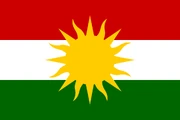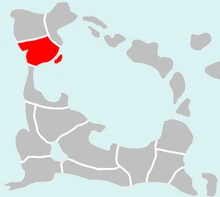Motto | |||||
| Anthem | "Lift up your head to the rising sun, Barmenistan" | ||||
| Capital | Sekhmet | ||||
| Largest city | Sekhmet | ||||
| Language official |
Brmek | ||||
| others | Kathuran, Selucian | ||||
| Religion main |
28% Ahmadism •20% Israi •6% Halawi •1% Abadi •1% Other 26% Felinism | ||||
| others | 25% Hosian •18% Barmenian Apostolic •4% Osean •2% Aurorian •1% Other 9% Ruhi 5 % Irreligious 3% Yeudi 1% Gerajat 1% Zollism 2% Other religion | ||||
| Ethnic Groups main |
44% Brmek 21% Kathuran | ||||
| others | 7% Arev Mardik 5% Seluco-Barmenian 4% | ||||
| Demonym | Barmenian | ||||
| Government | Socialist Presidential Republic | ||||
| Supreme Representative | Radu Nishani | ||||
| Legislature | Revolutionary People Power Assembly | ||||
| Area | 856.800 km² | ||||
| Population | 41,043,298 (4743 estimate) | ||||
| GDP Total: |
BAR 2,496,562,386,324 | ||||
| per capita | BAR 25,060 | ||||
| Established | 4476 (current Republic) 2142 (first modern Barmenian state) | ||||
| Independence | from Ahmadi Caliphate | ||||
| declared | 1486 (as Bunjamínid Caliphate) | ||||
| Currency | Barmenistan (BAR) | ||||
| Time Zone | GMT -1.5 | ||||
| summer | GMT -0.5 | ||||
| Drives on the | Right | ||||
| Calling Code | +49 | ||||
| Internet TLD | .bar | ||||
Barmenistan (Brmek: برمستات Brmestán), officially the Barmenistani Social Republic (Brmek: برمیک یزفرلیعدسرلی رکفکنس, Brmék Jezvraljogadsrlji Rekvakns ) is a nation situated on the continent of Majatra. It is bordered by the Red Bass Ocean to the west, Beiteynu to the north-west, Pontesi to the north-east, the Majatran Sea to the east, and Vanuku to the south.
Barmenistan is a Jelbic nation closely aligned with the other nations of the Jelbo-sphere, most significantly Vanuku.
Barmenistan is the historical center of several of the world's major religions, including Felinism and Ahmadism, both of which were founded in Barmenistan. The Ruhi Faith was also founded in Barmenistan.
Etymology[]
The Luthorian word Barmenistan has been used interchangeably with the name Barmenia. Though either name can be used, since the resurgence of Jelbicism in Barmenistan the former is preferred because it more accurately mirrors the Brmek name for the nation, Brmestán. This term is closely related to the Old High Jelbic Brme, a name still used by other Jelbic speakers.
History[]
Qedarite rule[]
The history of Barmenistan is believed to begin with the settlement of Qedarite (OOC: Semitic) tribes during the Qedarite Migrations, a semi-mythical population movement from the east to the continent of Majatra. Over the next millennia most of the territory of Barmenistan would be inhabited by Qedarite-speaking tribes. Later a large part of Barmenistan was colonized by Cildanian and Selucian city-states, most of which would be brought under the rule of the Cildanian Hegemony. In Barmenistan, the Qedarite tribes became differentiated from the other Qedarites, with Kathuran becoming the dominant language in the region and the official language of Cildanian-ruled Barmenistan.
Jelbo-Tukaric migrations and Beiteynuese rule[]
The Cildanian Hegemony was brought to an end as a result of the Jelbo-Tukaric Migrations, a series of population movements that saw Jelbo-Tukaric tribes invade and occupy Cildanian-ruled territories in Majatra. The Migrations would reach Barmenistan a few centuries afterwards. But Barmenistan would remain outside core Jelbic territory and Jelbic rule in the region was tenuous. Most of the territory of Barmenistan was in the 10th century brought under the rule of the Sacred Monarchy of Beiteynu, a Yeudi theocratic monarchy established in Beiteynu. Under the Sacred Monarchy many Barmenian Jelbics adopted Qedarite (Abrahamic) religions, including Hosianism, Oseanism, and Yeudism, and it is this multi-religious and multi-ethnic environment that eventually led to the birth of Ahmadism.
Ahmadism and the Caliphate[]
In 1154 the Sacred Monarchy collapsed, and various tribes under Beiteynuese rule established their independent states, the largest of which was the Hosian and Kathuran Kingdom of Arakhim. In 1186, Prophet Ahmad emerged in Sisula founding Ahmadism, and after the death of the Prophet in 1233 the Ahmadi Caliphate was established and proceeded to conquer most of the continent of Majatra. Most of the Barmenian territory was united under the Caliphate, but the Kingdom of Arakhim successfully resisted conquest until 1432, when it fell to Caliphal armies. For the next few centuries Barmenistan would thus be united under the Ahmadi Caliphate. In 1486 the Caliphate disintegrated into its component parts, although the Caliph would continue to rule in Barmenistan, until he was overthrown in 2142 and a Democratic Republic was proclaimed instead.
Republican era[]
The Republican era lasted for several centuries, however it was marked by instability, civil war, and foreign occupation. In the 24th century Barmenistan joined the Nrljogad (Jelbic Enlightenment) by adopting Old High Jelbic and modernizing Jelbic nationalism, while aiming to reduce the strong influence religion played in government.
Rule by multiple foreign entities[]
Beginning with 2768 Barmenistan would find itself under the rule of numerous foreign entities. That year Luthori attempted to restore the Caliphate to the Barmenian throne, which succeeded for a short time between 2779 and 2791, but was overthrown in a socialist revolution. A renewed attempt to establish a monarchy succeeded in 2806 with the coronation of Alexander I of the Hulstrian House of Rothingren-Traugott, as a temporary arrangement until he was succeeded by the Luthori-backed Caliphate. In 2872 republican Vanuku invaded and occupied Barmenistan in order to remove the foreign-backed monarchy, establishing the Federal Republic of Barmenistan that would rule until 2951, when the Selucian House of Victoria overthrew the Vanukean occupation and established the Grand State of Barmenia, a Selucian-ruled apartheid regime.
Felinism[]
The collapse of the Selucian monarchy left a power vacuum that was soon filled by a new religion born in Barmenistan, Felinism. Building on the traditional mythologies of the Jelbic and Qedarite peoples with heavy influence from Selucian Paganism and Selucian Hosianism, Felinism was reformed and formalized in the 32nd century and in 3134 Barmenistan was proclaimed a Feline Homeland, and a cat was installed as head of state. Henceforth Barmenistan would be marked by frequently violent conflicts between Felinism and Ahmadism. In 3389 Felinist Barmenistan became an elective monarchy, leading to the subsequent rise to power of the Mede Dynasty under the Felinist Republic of Barmenia. Felinist and Mede rule in the nation would last until 3788.
Temrkai and the Khaganate[]
The rise of the Jelbic Renaissance in the 36th-39th centuries, characterized by a return to traditional Jelbic forms of political organization, also engulfed Barmenistan. In 3638, as a result of the Barmenistan-Vanuku War, the nation was conquered by Augustan warlord Temrkai Khan and integrated into his personal Jelbic empire. Although Temrkai's empire disintegrated soon after his death, this marked the emergence of pan-Jelbism in Barmenistan, and in the following centuries the Mede and Temrkai-Mede monarchs eagerly embraced Jelbic traditions. Felinist Barmenistan was overthrown once again in 3788, uniting it with the other Jelbic nations under the Empire of the Jelbic Peoples. The short-lived Genzid Caliphate that ruled Barmenistan afterwards is responsible for the Felinist genocide that nearly brought Felinism to an end in the nation, and in its aftermath Barmenistan was brought under Hosian Kathuran minority rule.
Nasir Dynasty[]
The collapse of the Barmenian political system and the drastic reduction in the number of Felinists allowed the nation to be brought under a Kathuran apartheid regime. The Republic of Barmenia and the subsequent Kingdom of Barmenia initiated a number of discriminatory and genocidal policies against the majority Israi population. Under the Nasir Dynasty Barmenistan would exist as an elective constitutional monarchy with a heavily restricted franchise. At the same time several grass-roots movements helped Felinism gradually regain its demographic weight over the centuries, and in time a convergence of interests between the equally persecuted Ahmadis and Felinists emerged that ultimately led to the collapse of the Nasir kingdom.
Thallerid Sultanate[]
The kingdom was overthrown in 4262, and in 4266, a prince of the Thaller Family from Narikaton named Jens V ascended to rule in Barmenistan. Under Thallerid rule a revival of Jelbicism took place in Barmenistan leading to the creation of the Union of the Jelbic Peoples, while non-Felinists and Ahmadis were heavily persecuted. Jens was succeeded by his twin grandsons, Intrsmor and Jemrjkai, who jointly ruled the nation until the assassination of Jemrjkai in 4297 and a subsequent republican coup in 4298. Sultan Intrsmor would hold on to power for two more years in the city of Sekhmet, until he too was overthrown by republican forces in 4300, unifying the nation under the Federal Republic of Barmenistan.
Second Republican Era[]
Geography[]
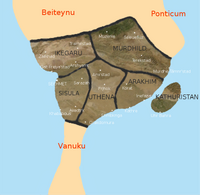
Map of Barmenistan
Barmenistan covers an area of 856.800 km². Known as the "Land of A Million Mountains", the country's terrain is decidedly rugged and punctuated with two major mountain range on in the north and another in the far south close to the Vanukean border.
The country has a generally continent climate with hot summers and very cold winters. The island of Arhe trzy Kafrestán has a somewhat more tropical climate. The mainland is infamous for its extremely fertile lands which make the country an agricultural powerhouse.
Government and politics[]
Government[]
Barmenistan is a presidential republic with a popularly-elected Shophet serving as its head of state and government. It is divided into six Prtastat (Regions). The Revolutionary Command Council serves as the legislature with members elected for six year terms.The judiciary is organised under two structures - the revolutionary courts known as the Popular Revolutionary Tribunals and the regular criminal and civil courts which adjudicate on regular disputes.
Political parties and elections[]
Foreign relations[]
Administrative divisions[]
Barmenistan is divided into six Provinces (Prtastat), each governed by a Governor (Yntmkmokai) named by the Head of State, voted on by the Assembly and retained via a vote of the people.
ever, as part of a push for modernization and centralization, more and more powers were returned to the central government. Following the establishment of the Kathuran minority regime under the Republic and later the House of Nasir, the Barmenian state underwent a long period of reform and centralization, culminating in the creation of an elected nobility (replacing the old, aged system of appointed Governorship). By the time of the death of King Amfn in 3937, most of the nation's decision making came from the Assembly and the monarch. Under the long lasting Federal Republic, ended in the '70s of 44th century, the principle of subsidiarity returned to regulate the relations between local governments and the central one. Barmenistan was formerly governed under a system of confessionalism, a de jure mix of religion and politics based on the proportional distribution of political and institutional power among religious communities. All post|}Military[]

War flag of the Caliphate
The military of Barmenia had for a long time been built around the idea of an autonomous and decentralized warrior caste. The government had only directly operated a small part of the Empire's military, and mostly subcontracted semi-military control to private entrepreneurs, bringing a system of competition to the Barmenian millitary which is believed to have led to great improvements to its quality, combined with the compulsory conscription of all young Barmenian men and women. There were also many paramilitaries belonging to one of the political parties, or acting independently or working on a regional basis. One of the more famous paramilitaries is the Legion of the Fourth Sword, who shot down a Pontesi airplane violating Barmenian aerospace. Since the onset of the second republican era, the Barmenian army has been transformed into a more common and professional army with the State operating virtually all of the military forces directly..
Economy[]
Demographics[]
Religious groups[]
- Ahmadism 28%
- Barmenian Apostolic Church 18%
- Oseyim 4%
- Aurorian Patriarchal Church 2%
- Other 1%
- Ruhi Faith 9%
- Irreligious 5%
- Yeudism 3%
- Geraja 1%
- Jelbic Shamanism 1%
- Other 2%
Ethnicity[]
- Brmékai 44%
- Kathuran 21%
- Arev Mardik 7%
- Other Jelbic 7%
- Seluco-Barmenian 5%
- Augustan 4%
- Yeudi 4%
- Zaqrami 2%
- Majatran 1%
- Other 5%
Culture[]
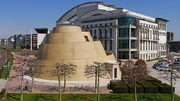
Modern cat temple in Varishehr, Murdhild, combining elements of ancient Qedarite and Selucian architecture
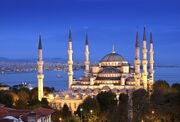
Mosque in Varishehr
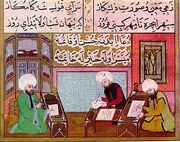
Barmenian miniature painters
Barmenian culture evolved out of the centuries of interaction between Jelbic culture and the native Majatran cultures, with the former absorbing, adapting, and modifying the cultures of conquered lands. As the starting point of the Ahmadi Empire, Barmenistan was strongly influenced by the customs and languages of other Ahmadi societies, who were in turn influenced by Jelbic Barmenian culture. As the Ahmadi Empire expanded it assimilated the culture of numerous regions under its rule and beyond, being particularly influenced by the Augustan Empire, the Qedarite cultures of Arakhim, Beiteynu, and Cildania, and Selucian culture.
Though minorities of Kathuran, Arev Mardik, Seluco-Barmenian, and Yeudi descent exist, nearly all Barmenians are fluent in Brmék, a dialect of the Jelbic language family, largely mutually intelligible with other Jelbic languages such as Jelbék, Wrnukaék, and Pnték.
Sports[]
Holidays[]
Symbolism[]
| Nations of Majatra | |
|
| |

